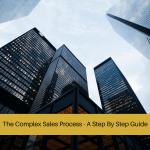
Qualifying Sales Leads – A Step By Step Guide
Qualifying sales leads is one of the most important tasks of the sales process.
The reason qualifying sales leads is so crucial in sales, is because by doing so correctly you’ll save a ton of time, energy, and potentially money.
In this guide, you’ll learn the importance of qualifying sales leads, how to do so, as well as a list of qualifying sales leads questions to help you with the task.
Qualifying Sales Leads – A Step By Step Guide
What Does Qualifying Sales Leads Mean?
When a potential client shows interest in your product or service, you’ll need to qualify them to ensure they’re the right fit for your offer.
Qualifying sales leads means to go through a process to ensure they are in fact the right fit for your offer or service, and that you feel they’re the right fit for you.
It’s a two-way street.
Many Sales Professionals think that anyone could be their potential client, or just because they tick the required boxes – that they will work fine with you as a client.
This isn’t always the case.
Qualifying sales leads correctly means ensuring that you can in fact serve their needs correctly, and then then secondly – be a client you’d be happy to work with.
Disqualifying Sales Leads
Qualifying sales leads isn’t just an activity to see whether they’d be the right fit as a client for you.
As mentioned – you want to ensure they’d be someone you can actually serve and be happy to have a business relationship with.
Not all clients are equal – some clients are an absolute breeze to work with, and then there are others; they pay you the same, but take a lot more time, attention, and never seem happy with any kind of service you provide.
When qualifying your sales leads, you should go through a process to ensure they’re not only the right fit for your product or service, but someone you would want to work with too.
Finally – it’s imperative to disqualify someone who wouldn’t get the value they’re looking for when speaking to you about your product or service.
From an integrity standpoint – not only is this the right thing to do, but they’ll spread the word about how you are someone that can be trusted.
Related article: Not All Clients Are Equal
Qualifying Sales Leads – Using BANT
BANT is an excellent acronym and framework to use when qualifying sales leads:
- It’s simple
- Easy to remember
- Works well to ensure you’re speaking with people who would qualify for your product or service
IBM originally created BANT to help their Sales Professionals when qualifying sales leads, to streamline their sales conversations and be more effective with their time.
Below is a breakdown of BANT, and how it relates to qualifying sales leads.
Related article: BANT In Sales – How Does It Work?
B – Budget
The first letter in BANT stands for budget, and this is important when qualifying sales leads.
It’s imperative that you learn early on when qualifying sales leads that they have the budget to find a solution for what they’re looking for.
Many Sales Professionals speak with potential clients, to only later find out toward the end of the sales conversation that there’s a large disparity between what they can afford, and what an outcome will cost.
Notice at this stage – I haven’t directly asked what their budget is for your product or service.
Although this is important – we don’t want to make the mistake of going into ‘premature presentation’ mode and talk about what we sell.
Instead – we want to understand what they’ve approximately put aside budget wise to spend on a solution.
A – Authority
The second letter of BANT is authority; when qualifying sales leads, it’s crucial that you’re speaking with decision makers, or it is clear that the next step will involve you speaking with a person who will make a buying decision.
At The 5% Institute, we teach our students that you want to speak with decision makers as early as possible, so you don’t have someone else presenting on your behalf, and secondly – to avoid the “I need to speak to” sales objection.
When learning about authority, try to find out who the decision maker is, how many people may be involved, how they make purchasing decisions, and how they’ve bought similar products or services in the past.
N – Need
If a person feels like they have no real need for a solution to their problem, they won’t make a buying decision. Thus – the next set of questions when qualifying sales leads is to ensure they have a need for your product or service.
The way you can identify whether they have a need or not, is by asking a set of questions that’ll outline their current negative situation, and the pain caused by being in such a situation.
People buy to alleviate pain, and to move towards pleasure.
Ten example questions to find pain, and a need for a solution are below:
- Can you give me some background to this issue?
- How long have you been having this issue for?
- What’s this costing you yearly?
- Is this affecting your clients?
- How long have you had this issue?
- How many hours does this issue cost you?
- Is this challenging you and your business?
- What’s the biggest issue with this?
- How important would you say finding a solution is?
- Have you been looking for a solution to this problem for a while?
Finding pain is critical when qualifying sales leads. To learn how to do so effectively, read the linked article below.
Further reading: Pain Points & Sales – Your Ultimate Guide
T – Time Frame
Finally, the last letter of BANT stands for time frame. The reason the time frame is important when qualifying sales leads, is you want to make sure you can meet their needs.
A potential client may have the money, authority, and need for a solution – but if you’re not clear on when you can provide a solution, or you can’t meet their expectations – it can be risky for your business.
The time frame; and any associated communication and expectations around what that looks like is key when starting a new relationship with a client.
By doing so – you’ll start on the right foot, and it’ll be clear whether or not you can serve their needs.
Some of the risks of taking on a client without being able to meet their time frame is:
- Reputation damage
- Legal damage
- Morale damage
Questions To Ask When Qualifying Sales Leads
Below are ten example questions you can use when qualifying sales leads effectively:
- What issue would you like solved?
- Tell me about the problems you’d like discussed today?
- How come you haven’t solved the issue up till now?
- What happens if you stay as you are?
- How much have you thought about putting aside to fix this issue?
- Who else is involved when making a decision?
- What hurdles do you think could present themselves from solving this issue?
- Tell me what success looks like – solution wise and time frame?
- When do you need this solved by?
- What happens if we could solve this for you?
Related article: Leads vs Opportunities – What’s The Difference?
Qualifying Sales Leads – Final Thoughts
Qualifying sales leads is one of the most important parts of the sales process, because it’s critical to be using your time, resources and budget effectively.
By using a qualifying sales leads process, you’ll be able to figure out quickly during your discovery call as to whether the potential client is exactly that – or not the right fit for your business.
To learn more about what you should cover in the discovery call – read the linked article below for more details.
Further reading: The Discovery Call – Your Ultimate Guide
Want To Close Sales Easier?
Are you committed to closing sales a lot easier, and consistently?
If so, you should check out our self-paced and affordable online sales training program; The 5% Sales Blueprint.
It’ll give you everything you need to close sales consistently.
To learn more, simply click on the link below for more information.
Our Online Sales Training Program – The 5% Sales Blueprint.



